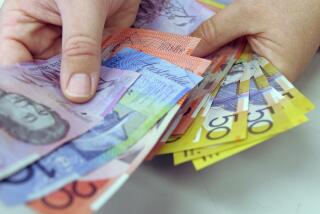Britain’s Royal Mint opts for a pound of prevention with new coin
- Share via
LONDON — Trying not to be penny-wise but pound-foolish, Britain announced Wednesday that it will ditch its venerable round 1-pound coin in favor of a new 12-sided model specially designed to foil counterfeiters.
The new piece, to enter circulation in 2017, will maintain the nugget-like size of the current version, about the diameter of a U.S. nickel and nearly twice as heavy. But it will incorporate different-colored metals, for a faux gold and silver look, instead of the mostly copper blend now in circulation, and boast a high-tech anti-forgery feature used in paper money that remains shrouded in secrecy by the Royal Mint.
“After 30 years’ loyal service, the time is right to retire the current 1-pound coin and replace it with the most secure coin in the world,” Chancellor of the Exchequer George Osborne said in a statement. “It’s vital that we keep several paces ahead of the criminals to maintain the integrity of our currency.”
The dodecagonal shape of the new pound coin is a throwback, however, recalling the old 12-sided “threepenny [pronounced THRUP-ney] bits” that jangled in pants pockets until they were phased out in 1971.
“We think it’s suitably British,” Adam Lawrence, the chief executive of the Royal Mint, told the BBC.
Like all coins of the realm, the new piece will bear the likeness of the monarch, currently Queen Elizabeth II, on the “heads” side. The design on the reverse will be decided through a public contest.
The revamp is part of a flurry of changes to British money under the stewardship of the new governor of the Bank of England, Mark Carney, a Canadian who took up the high-profile post in July.
In his first weeks on the job, Carney bowed to the complaints of women angry about the dearth of female historical figures on British currency by unveiling a 10-pound note that will feature a portrait of author Jane Austen. Like the new pound coins, those notes are to be introduced in 2017.
In 2016, the Bank of England is expected to start issuing plastic bank notes, which are harder to counterfeit and hardier than paper money, capable of surviving the punishing spin cycles of modern washing machines.
Switching to the new 12-sided pound coins will mean overhauling thousands of supermarket self-checkout machines, parking meters, gym lockers and vending machines, at a potential cost to the British economy of up to $30 million.
But the Treasury has decided that, when it comes to preventing fraud, an ounce of prevention is worth a pound of cure. As many as 3% of the estimated 1.5 billion pound coins in circulation are fakes, with a collective face value of nearly $75 million. (One pound equals about $1.65 at current exchange rates.)
The thick round coin so beloved by Brits and so familiar to sticker-shocked tourists was itself an innovation. The Royal Mint introduced the coin in April 1983 to replace the tiny pound note, which had lost much of its purchasing power over the years and was susceptible to wear and tear.
A 2-pound piece debuted in 1998, a single (and easily spent) coin worth $3.30.
More to Read
Sign up for Essential California
The most important California stories and recommendations in your inbox every morning.
You may occasionally receive promotional content from the Los Angeles Times.











